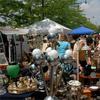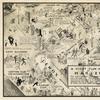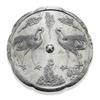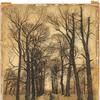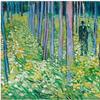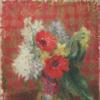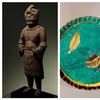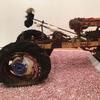Clark Art Institute Debuts New Decorative Arts Gallery
- WILLIAMSTOWN, Massachusetts
- /
- February 15, 2017
The Clark Art Institute opens the Henry Morris and Elizabeth H. Burrows Gallery on Sunday, February 19. The American decorative arts gallery, housed in 3,275 square feet of newly renovated space in the Manton Research Center, contains the Clark’s important collection of early American paintings and furniture in addition to its exceptional Burrows collection of American silver. Designed by Selldorf Architects, the gallery includes new exhibition cases and an improved layout that enhance the experience of viewing the Clark’s important collection of colonial to early-nineteenth-century American art. Kathleen Morris, Sylvia and Leonard Marx Director of Exhibitions and Curator of Decorative Arts, and Curatorial Research Associate Alexis Goodin will present an opening lecture on the new gallery at 11:30 am on February 19.
The gallery, located in former exhibition spaces on the upper level of the Manton Research Center, features more than 300 objects, many which have been off view since 2012 and some of which have never been exhibited. Highlights of the display include an iconic portrait of George Washington (1796–1803) by Gilbert Stuart (American, 1755–1828); a beautifully scaled sugar bowl and cover (c. 1795) by Paul Revere, Jr. (American, 1735–1818), and a graceful Sheraton-style secretary (c. 1800) attributed to Nehemiah Adams (American, 1769–1840). The gallery also includes a study center containing additional displays of silver, a computer station, and a small library of books on American silver and furniture, allowing scholars and visitors to further their study of the works on view.
“The Clark’s collection of American decorative arts has been assembled largely through generous donations of important collections,” said Olivier Meslay, Felda and Dena Hardymon Director of the Clark. “We are so pleased to be able to honor the Burrowses, whose keen eyes and collecting acumen built an exemplary collection, and are indebted to them for their generosity in making such an important gift to the Clark. This new gallery, named in their honor, allows us to provide well-deserved prominence to this lesser-known facet of our collection.”
Very little of the Clark’s early American collections stems from the Institute’s founders. It has been developed over time through gifts, most significantly the 2003 Burrows bequest of more than 272 pieces of American silver. In 2001 thirty pieces of colonial and Federal furniture and small decorative arts assembled by distinguished collector George Cluett were received through a bequest from his daughter Florence Cluett Chambers. In 2010 and 2013, Phoebe Prime Swain donated twenty-eight pieces of Chinese export porcelain from the George Washington Memorial Service, each decorated with a memorial to the first president. While several museums own one or two pieces from this noted service, the Clark now has the largest holding of any public institution, featuring diverse forms such as platters, bowls, sauceboats, and custard cups.
“With the leadership of Selldorf Architects, we have converted our former temporary exhibition space into a suite of permanent collection galleries,” said Kathleen Morris. “It is exciting to see these objects, many of which were formerly in storage due to lack of space, assembled in such a warm and welcoming environment.” The reinstallation project included extensive object research conducted by Morris and Alexis Goodin. This research revealed important information about the collections. For example, a looking glass purchased by Cluett, thought to be a rare example from New York, was actually made in Bremen, Germany. Most likely made for the American market, the looking glass was the subject of an intensive research and conservation project in 2015.
The items housed in the Burrows gallery reflect how early American artists and craftsman created a new artistic identity for the fledgling nation through the creation of beautiful, but functional, objects. Their designs demonstrate a knowledge and appreciation of luxury objects being made at the time in Europe, especially in England, but also show a tendency toward a greater simplicity in form and decoration.
The Burrows collection provides a rich overview of silver production in the colonial and Federal periods. The collection is installed with three themes in mind: historic connections; the development of distinct styles in the major centers of silver production (Boston, New York, and Philadelphia); and social uses of silver for serving tea and coffee, drinking alcoholic beverages, dining, presentation, and personal use. Major silversmiths such as Paul Revere, Jr., Myer Myers (1723–1795), and the Richardson family of Philadelphia are well represented, as are many silversmiths working in smaller cities. The installation features nearly the entire Burrows collection.
The Cluett Chambers collection of furniture and decorative arts includes fine examples of case furniture, looking glasses, and clocks. Notable pieces include an imposing desk and bookcase (c. 1770) made in Massachusetts with exuberantly carved “hairy-paw” feet and some fifty-two interior drawers and pigeonhole dividers. An elegant Sheraton-style secretary (1800–1810) attributed to Nehemiah Adams represents the most expensive type of furniture sold in Salem, Massachusetts furniture shops of the time, designed to emphasize the wealth, taste, and erudition of its owner. The Cluett Chambers collection also reveals that imported goods continued to have a place even as the furniture industry in America developed—for example, the collection features looking glasses made for the American market in England and Germany, a gilded bronze clock made in Paris celebrating George Washington, and porcelain and silver imported from China.
The installation is enriched by loans from four private collections. Among these works is the portrait Catherine Couenhoven Clark (1819–1820) of Troy, New York by Ammi Phillips (American 1788–1865), which complements the Clark’s portrait Harriet Campbell (c.1815). The painting is on loan from Nathan Kernan (Couenhoven’s great-great-grandson) and Thomas Whitridge. Another loan object, an elegant pie-crust tea table, stands near a large display of silver made for serving tea and coffee. Additional loans include a mid-eighteenth-century Connecticut side chair; a high chest of drawers (c. 1780–85) attributed to Eliphalet Chapin (American, 1741–1807) and also from Connecticut; another high chest of drawers from Philadelphia of the late 1750s with carving attributed to Nicholas Bernard (American, d. 1789); and a pair of c. 1789 paintings by Christian Gullager (American, 1759–1826), Major Benjamin Shaw and Mehitable Shaw.
The installation of the Henry Morris and Elizabeth H. Burrows Gallery is supported by a grant from the Henry Luce Foundation.

